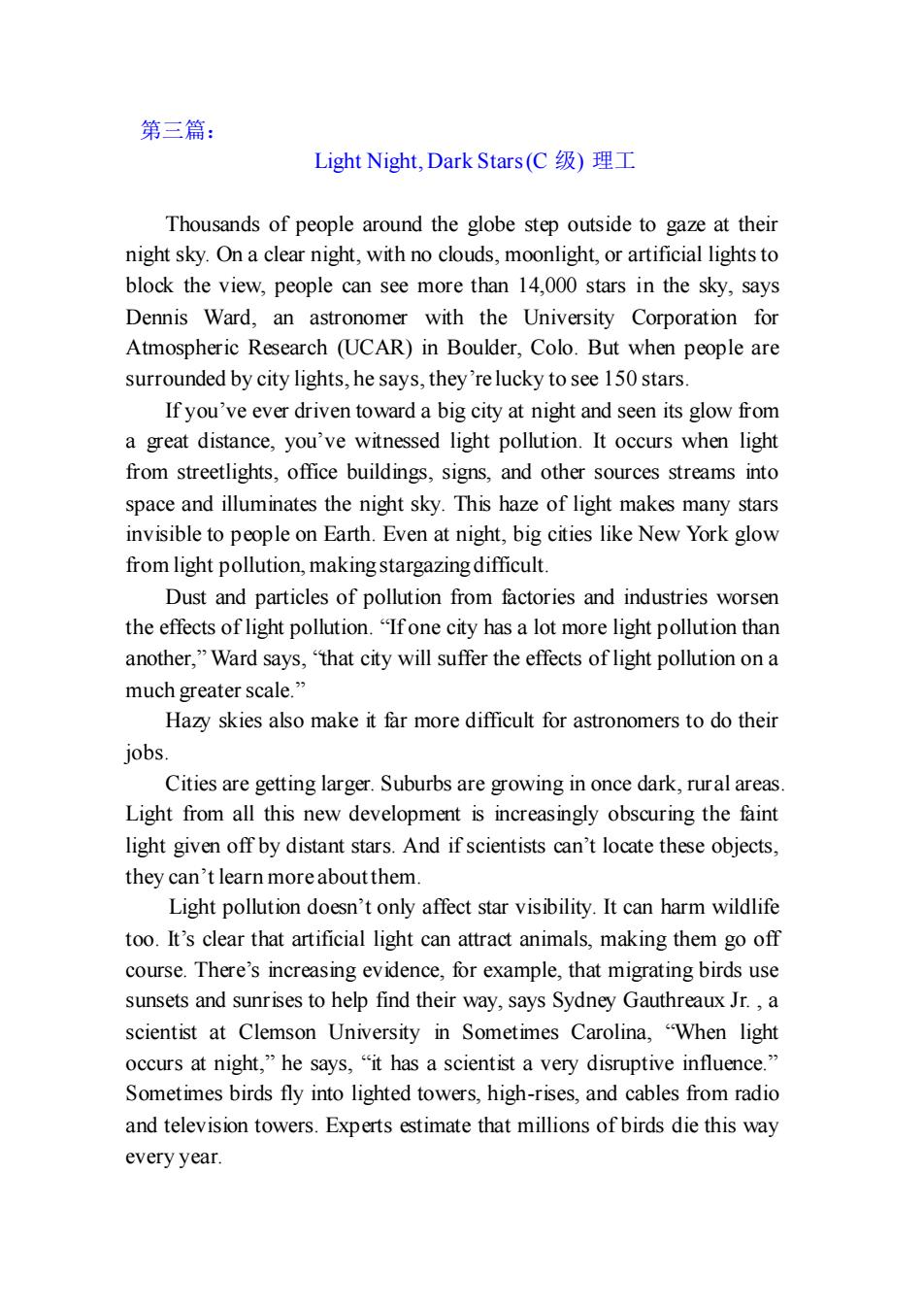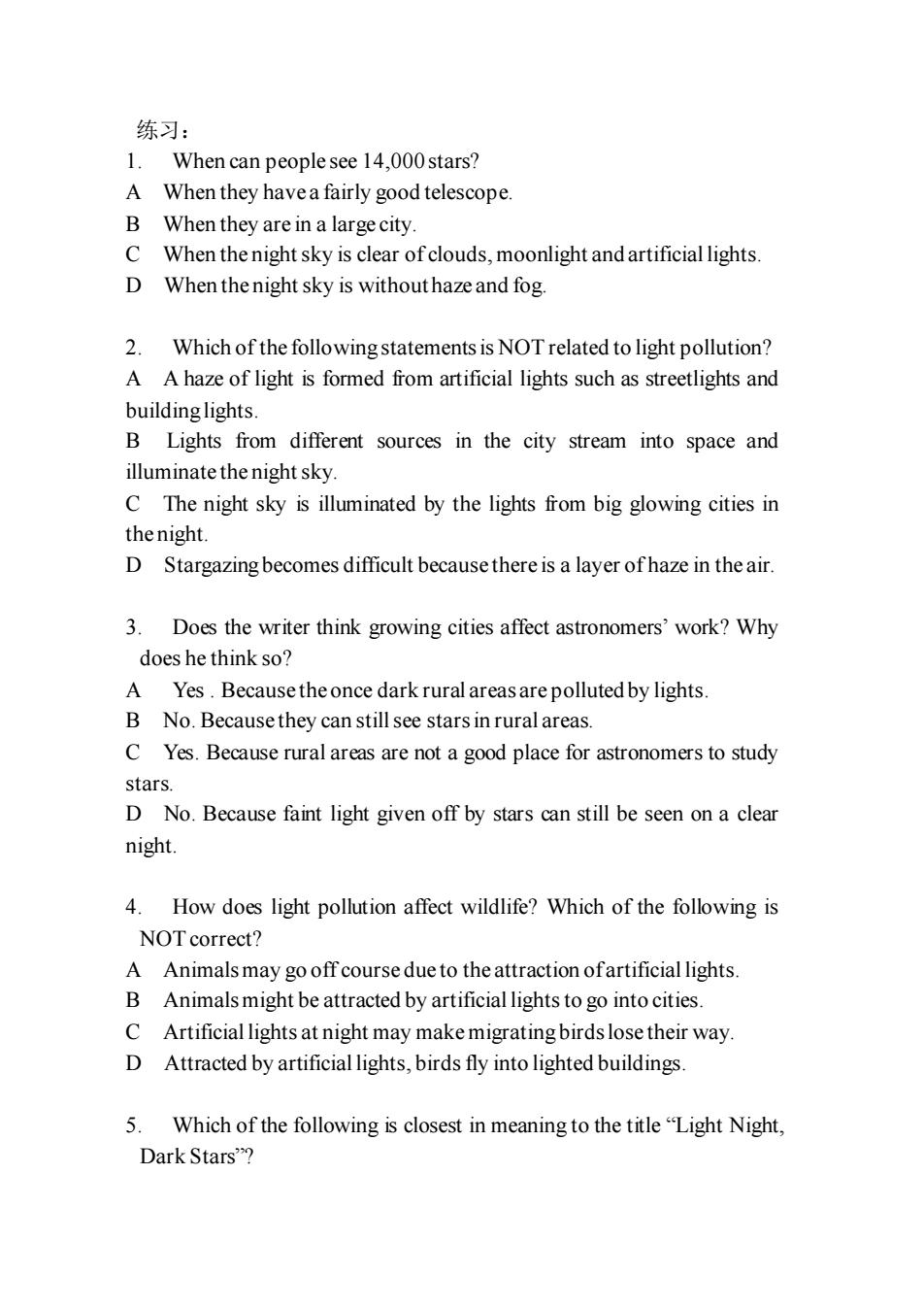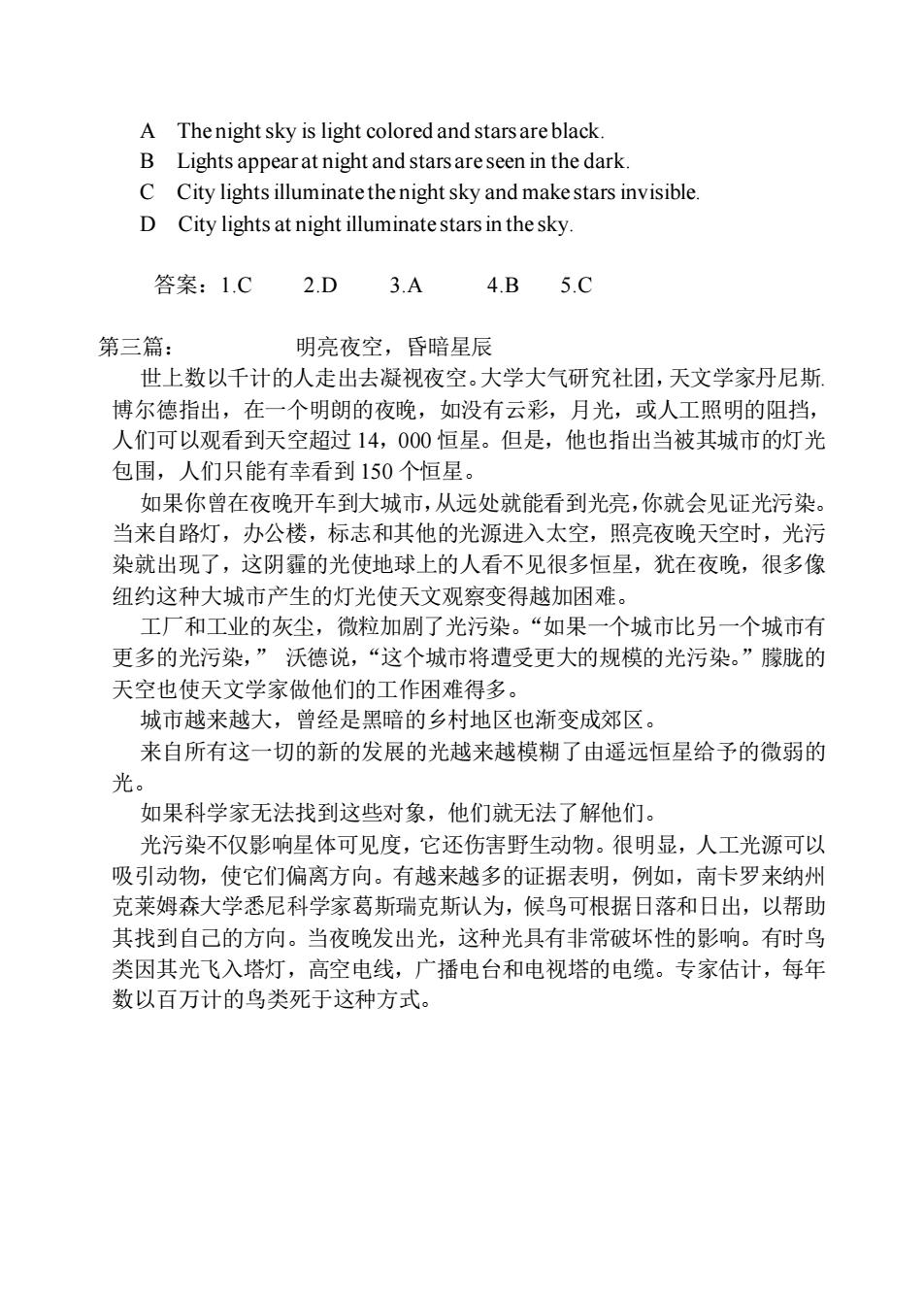
第三篇:Light Night,Dark Stars(C 级)理工Thousands of people around the globe step outside to gaze at theirnight sky. On a clear night, with no clouds, moonlight, or artificial lights toblock the view, people can see more than 14,000 stars in the sky, saysDennis Ward, an astronomer with the University Corporation forAtmospheric Research (UCAR) in Boulder, Colo. But when people aresurrounded by city lights, he says, they're lucky to see 150 stars.If you've ever driven toward a big city at night and seen its glow froma great distance, you've witnessed light pollution. It occurs when lightfrom streetlights, office buildings, signs, and other sources streams intospace and illuminates the night sky. This haze of light makes many starsinvisible to people on Earth. Even at night, big cities like New York glowfrom light pollution, making stargazingdifficult.Dust and particles of pollution from factories and industries worsenthe effects of light pollution. “If one city has a lot more light pollution thananother," Ward says, "that city will suffer the effects of light pollution on amuchgreaterscale."?Hazy skies alsomake it far more difficult for astronomers to do theirjobs.Cities are getting larger. Suburbs are growing in once dark, rural areas.Light from all this new development is increasingly obscuring the faintlight given off by distant stars. And if scientists can't locate these objects,they can't learn moreaboutthem.Light pollution doesn't only affect star visibility. It can harm wildlifetoo. It's clear that artificial light can attract animals, making them go offcourse. There's increasing evidence, for example, that migrating birds usesunsets and sunrises to help find their way, says Sydney Gauthreaux Jr. , ascientist at Clemson University in Sometimes Carolina, When lightoccurs at night," he says, “it has a scientist a very disruptive influence."Sometimes birds fly into lighted towers, high-rises, and cables from radioand television towers. Experts estimate that millions of birds die this wayeveryyear
第三篇: Light Night, Dark Stars (C 级) 理工 Thousands of people around the globe step outside to gaze at their night sky. On a clear night, with no clouds, moonlight, or artificial lights to block the view, people can see more than 14,000 stars in the sky, says Dennis Ward, an astronomer with the University Corporation for Atmospheric Research (UCAR) in Boulder, Colo. But when people are surrounded by city lights, he says, they’re lucky to see 150 stars. If you’ve ever driven toward a big city at night and seen its glow from a great distance, you’ve witnessed light pollution. It occurs when light from streetlights, office buildings, signs, and other sources streams into space and illuminates the night sky. This haze of light makes many stars invisible to people on Earth. Even at night, big cities like New York glow from light pollution, making stargazing difficult. Dust and particles of pollution from factories and industries worsen the effects of light pollution. “If one city has a lot more light pollution than another,” Ward says, “that city will suffer the effects of light pollution on a much greater scale.” Hazy skies also make it far more difficult for astronomers to do their jobs. Cities are getting larger. Suburbs are growing in once dark, rural areas. Light from all this new development is increasingly obscuring the faint light given off by distant stars. And if scientists can’t locate these objects, they can’t learn more about them. Light pollution doesn’t only affect star visibility. It can harm wildlife too. It’s clear that artificial light can attract animals, making them go off course. There’s increasing evidence, for example, that migrating birds use sunsets and sunrises to help find their way, says Sydney Gauthreaux Jr. , a scientist at Clemson University in Sometimes Carolina, “When light occurs at night,” he says, “it has a scientist a very disruptive influence.” Sometimes birds fly into lighted towers, high-rises, and cables from radio and television towers. Experts estimate that millions of birds die this way every year

练习:1.When can peoplesee 14,000 stars?AWhentheyhaveafairlygoodtelescopeBWhen they are in a large cityCWhenthenight sky isclear ofclouds,moonlightandartificial lightsDWhen thenight sky is withouthaze and fog2.Which of the following statements is NOT related to light pollution?AA haze of light is formed firom artificial lights such as streetlights andbuildinglights.BLights from different sources in the city stream into space andilluminate the night sky.CThe night sky is illuminated by the lights from big glowing cities inthenight.D Stargazing becomes difficult becausethere is a layer of haze in the air.3.Does the writer think growing cities affect astronomers' work? Whydoeshethinkso?AYes.Becausetheonce dark rural areas arepolluted by lightsB No. Becausethey can still see stars in rural areas.C Yes. Because rural areas are not a good place for astronomers to studystars.D No. Because faint light given off by stars can still be seen on a clearnight.4.How does light pollution affect wildlife? Which of the following isNOTcorrect?AAnimalsmay go off course due to the attraction ofartificial lightsBAnimalsmight be attracted by artificial lights to go into cities.CArtificial lights at night may make migrating birds lose their way.DAttracted by artificial lights, birds fly into lighted buildings.5.Which of the following is closest in meaning to the title “Light Night,Dark Stars"?
练习: 1. When can people see 14,000 stars? A When they have a fairly good telescope. B When they are in a large city. C When the night sky is clear of clouds, moonlight and artificial lights. D When the night sky is without haze and fog. 2. Which of the following statements is NOT related to light pollution? A A haze of light is formed from artificial lights such as streetlights and building lights. B Lights from different sources in the city stream into space and illuminate the night sky. C The night sky is illuminated by the lights from big glowing cities in the night. D Stargazing becomes difficult because there is a layer of haze in the air. 3. Does the writer think growing cities affect astronomers’ work? Why does he think so? A Yes . Because the once dark rural areas are polluted by lights. B No. Because they can still see stars in rural areas. C Yes. Because rural areas are not a good place for astronomers to study stars. D No. Because faint light given off by stars can still be seen on a clear night. 4. How does light pollution affect wildlife? Which of the following is NOT correct? A Animals may go off course due to the attraction of artificial lights. B Animals might be attracted by artificial lights to go into cities. C Artificial lights at night may make migrating birds lose their way. D Attracted by artificial lights, birds fly into lighted buildings. 5. Which of the following is closest in meaning to the title “Light Night, Dark Stars”?

A Thenightskyis lightcoloredand starsareblackBLights appearat night and stars are seen in the darkCCitylightsilluminatethenightskyandmakestarsinvisibleDCity lights at night illuminate stars in the sky2.D3.A5.C答案:1.C4.B第三篇:明亮夜空,昏暗星辰世上数以千计的人走出去凝视夜空。大学大气研究社团,天文学家丹尼斯博尔德指出,在一个明朗的夜晚,如没有云彩,月光,或人工照明的阻挡人们可以观看到天空超过14,000恒星。但是,他也指出当被其城市的灯光包围,人们只能有幸看到150个恒星。如果你曾在夜晚开车到大城市,从远处就能看到光亮,你就会见证光污染。当来自路灯,办公楼,标志和其他的光源进入太空,照亮夜晚天空时,光污染就出现了,这阴霾的光使地球上的人看不见很多恒星,犹在夜晚,很多像纽约这种大城市产生的灯光使天文观察变得越加困难。工厂和工业的灰尘,微粒加剧了光污染。“如果一个城市比另一个城市有更多的光污染,”沃德说,“这个城市将遭受更大的规模的光污染。”朦胧的天空也使天文学家做他们的工作困难得多。城市越来越大,曾经是黑暗的乡村地区也渐变成郊区。来自所有这一切的新的发展的光越来越模糊了由遥远恒星给予的微弱的光。如果科学家无法找到这些对象,他们就无法了解他们。光污染不仅影响星体可见度,它还伤害野生动物。很明显,人工光源可以吸引动物,使它们偏离方向。有越来越多的证据表明,例如,南卡罗来纳州克莱姆森大学悉尼科学家葛斯瑞克斯认为,候鸟可根据日落和日出,以帮助其找到自已的方向。当夜晚发出光,这种光具有非常破坏性的影响。有时鸟类因其光飞入塔灯,高空电线,广播电台和电视塔的电缆。专家估计,每年数以百万计的鸟类死于这种方式
A The night sky is light colored and stars are black. B Lights appear at night and stars are seen in the dark. C City lights illuminate the night sky and make stars invisible. D City lights at night illuminate stars in the sky. 答案:1.C 2.D 3.A 4.B 5.C 第三篇: 明亮夜空,昏暗星辰 世上数以千计的人走出去凝视夜空。大学大气研究社团,天文学家丹尼斯. 博尔德指出,在一个明朗的夜晚,如没有云彩,月光,或人工照明的阻挡, 人们可以观看到天空超过 14,000 恒星。但是,他也指出当被其城市的灯光 包围,人们只能有幸看到 150 个恒星。 如果你曾在夜晚开车到大城市,从远处就能看到光亮,你就会见证光污染。 当来自路灯,办公楼,标志和其他的光源进入太空,照亮夜晚天空时,光污 染就出现了,这阴霾的光使地球上的人看不见很多恒星,犹在夜晚,很多像 纽约这种大城市产生的灯光使天文观察变得越加困难。 工厂和工业的灰尘,微粒加剧了光污染。“如果一个城市比另一个城市有 更多的光污染,” 沃德说,“这个城市将遭受更大的规模的光污染。”朦胧的 天空也使天文学家做他们的工作困难得多。 城市越来越大,曾经是黑暗的乡村地区也渐变成郊区。 来自所有这一切的新的发展的光越来越模糊了由遥远恒星给予的微弱的 光。 如果科学家无法找到这些对象,他们就无法了解他们。 光污染不仅影响星体可见度,它还伤害野生动物。很明显,人工光源可以 吸引动物,使它们偏离方向。有越来越多的证据表明,例如,南卡罗来纳州 克莱姆森大学悉尼科学家葛斯瑞克斯认为,候鸟可根据日落和日出,以帮助 其找到自己的方向。当夜晚发出光,这种光具有非常破坏性的影响。有时鸟 类因其光飞入塔灯,高空电线,广播电台和电视塔的电缆。专家估计,每年 数以百万计的鸟类死于这种方式